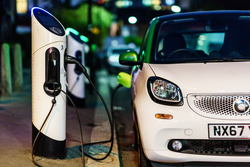What’s the situation for electric vehicles in the UK today?
 'As national and local Government invest in the necessary infrastructure, electric vehicles are increasing in popularity', said the Society of Motor Manufacturers and Traders (SMMT)[1]. In July 2019, there were 2,271 new battery electric vehicles (BEV) registrations compared with 880 in July 2018; a rise of 158%.
'As national and local Government invest in the necessary infrastructure, electric vehicles are increasing in popularity', said the Society of Motor Manufacturers and Traders (SMMT)[1]. In July 2019, there were 2,271 new battery electric vehicles (BEV) registrations compared with 880 in July 2018; a rise of 158%.
The number of hybrid electric vehicles have also increased – however, plug-in hybrids declined, presumably due to the reduction in government incentives.
SMMT forecasts that BEVs will double their market share in 2020, with 51,000 registrations expected. While that would still represent only 2.2% of the overall car market, it is clear that this is a vehicle trend that's only going one way.
It’s expected that the number of electric vehicles on the road around the world will hit 125 million by 2030[2].
BS EN IEC 61851-1:2019, Electric vehicle conductive charging system – Part 1: General requirements, is a new standard that focuses on the quality and consistency of the electric energy supply and the safety standards at charging stations, alongside the rest of the 61851 series.
Two kinds of responses to electric vehicles
Drivers tend to fall into one of two camps: you may already have an electric vehicle (or are in favour of them and may be considering a purchase), or you may simply think that it’s not the right vehicle travelling choice for you.
Green cars can be a wise move for the conscientious driver, as concerns grow about the negative effect of greenhouse gases on the environment and there are potential savings - with the introduction of London ultra-low emission zones.
For many buyers, however, electric vehicles are something of an unknown entity. There are fears about the range, reliability and availability of the charging infrastructure, leading some to believe that going green could mean going nowhere.
Whatever your opinion on electric vehicles, it’s an industry that is growing rapidly and will have an impact to both sides. In this article, we’re going to explore five areas that challenge green and traditional vehicle drivers alike.
Five challenges facing the electric vehicle industry and its drivers
1) The limited number of charge points
Most drivers are used to being only a few miles from a fuel station, so there have been worries about where to charge their vehicle while away from home. For disabled drivers, the problem can be even more acute, as the electric vehicle charging stations tend to be in standard-sized bays.
Solution:
While there are now 430,000 publically- accessible chargers worldwide[3], the number in the UK has overtaken the number of fuel stations[4]. The 2019 Nissan study found 9,300 electric vehicle (EV) charging locations across the UK, compared with 8,400 fuel stations. The number of bays designated for disabled drivers is also increasing.[5]
2: Range anxiety
Range anxiety describes the fear felt by electric vehicle drivers, who are concerned that their vehicle will not have sufficient stored energy to allow them to complete a desired journey. There is concern that there will not be suitable charging stations on route to their destination, so they feel limited by where they can go.
Solution:
In true community style, people have created helpful apps like ZAP map[6] to show drivers places that they can recharge, using their phone’s GPS location.
You can also find more information by looking at public records. The creators of Open Charge Map have a list that you browse through before embarking on a journey.
Outside London, cities such as Nottingham, Oxford, Milton Keynes and Bristol have already been awarded Go Ultra Low city status, with funding support to introduce initiatives to encourage the adoption of Ultra Low Emission Vehicles (ULEVs)[7].
3) Support for charging bays
What came first in a town - the charging bay or the electric vehicle?
While it’s true that local residents can ask for change when there is a demand for it, sometimes local councils or management can be slow to respond.
This is harder for places that have tightly-controlled spending budgets, or have other priorities on their agenda.
Since not every car owner has off-street parking, particularly in cities, it’s more useful to have more charging facilities close by residential areas
Solution:
As councils struggle to meet clean air requirements, many are investing in the infrastructure necessary to encourage residents to buy electric vehicles. The London Borough of Hackney, for example, aims for all households to be no further than 500 metres from a fast charging point by 2025.[8]
Increasingly, councils are looking at smarter solutions to integrate new technology into existing infrastructure. In one borough, lamp posts are being used to double up as charging points. [9]
4) Who pays for the electricity?
If you fill your car with petrol, you’d expect to pay for it yourself.
However, drivers have had some questions when considering the fuel implications for electric vehicles: Is it expensive to use a lot of electricity? Who else can pay for it? Is it really green to increase the demand for electricity in general?
Solution:
Currently, one full charge is relatively cheap: £8.40 for a range of about 200 miles.[10] But, if you’re charging at work or at a supermarket car park, your employer or the supermarket will foot the energy bill. Within London, the Mayor of London has funded some charging points.
For those more conscious of their energy footprint, there are other types of energy available too. You can switch to greener electricity sources, such as wind power at home, or even sign up for innovative solutions, such as providing energy from your vehicle battery to the grid at peak times.[11]
5) Problems with charging up at stations
Charging infrastructure is new technology, and anything involving power and the public needs to be safe and reliable. However, there can be differences at the charge point facilities that can cause confusion..
An example of this is fast charge. The time it takes to charge an electric car can be between 30 minutes to more than 12 hours. This depends on the size of the battery and the speed of the charging point.[12]
7kW and 22kW are considered a 'fast' charging point, and empty-to-full charging time averages at 4-5 hours. For 'rapid' charging points with 43kW-50kW and 150kW charging, the average empty-to-full charging time changes to approximately an hour.
Some charging points aren’t fast-charge and drivers expecting one at every charge point will be disappointed.
Drivers have also found different cables at the charge points, which differ to the type their car requires. This can cause frustration and give drivers an unpleasant experience.
Solution:
Traditionally, 22kW fast charge points are often reserved for electric vans and buses that need much more power. Drivers can find their nearest one using the Zap mobile app. Transport for London have 180 rapid charge points across London and are committed to installing 300 by 2020.[13]
Until then, grants are available for electric vehicle charging infrastructure at home and at workplaces.
For cables, some rapid car charging stations provide a tethered cable with a non-removable JEVS (CHAdeMO 50kW), CCS (Combo 50kW) or Tesla (50-120 kW) vehicle connectors.
There is some expert guidance available about how charging stations work and according to BS EN IEC 61851-1:2019, when it comes to using the right connection cables to charge your vehicle, there are three possibilities:
1) Connection with attached plug and cable, where the cable assembly is part of the vehicle.

2) Connection with cable and vehicle connector, where the detachable cable assembly is not part of the vehicle or the charging station.

3) Connection with cable and vehicle connector, where the cable assembly is part of the EV charging station.

The right approach here is to be prepared while growth and investment is put into the industry. Additional cables can be purchased from dealers, and drivers can check with their vehicle’s specifications to confirm the right cable for their needs.
For an inside look at how the experts are building up our energy infrastructure, purchase the standard from BSI’s shop where members get 50% off.
Did you find this article useful? Share it on social media using the #BSImembership to your friends and loved ones.

 'As national and local Government invest in the necessary infrastructure, electric vehicles are increasing in popularity', said the Society of Motor Manufacturers and Traders (SMMT)
'As national and local Government invest in the necessary infrastructure, electric vehicles are increasing in popularity', said the Society of Motor Manufacturers and Traders (SMMT)


